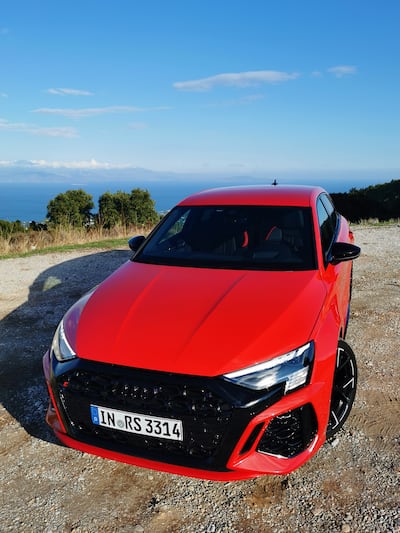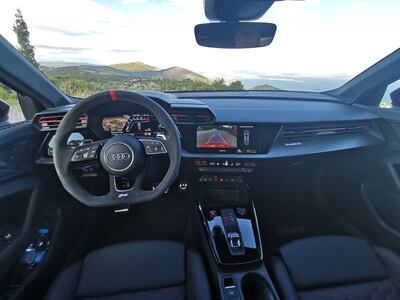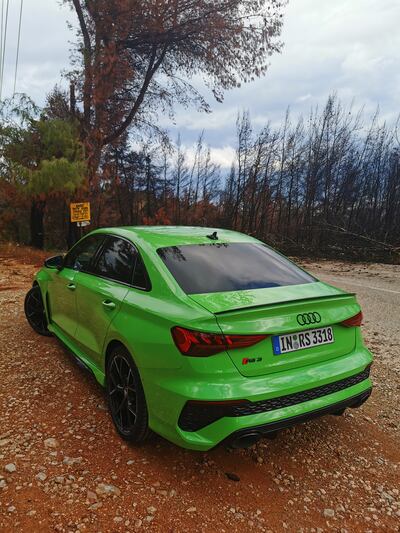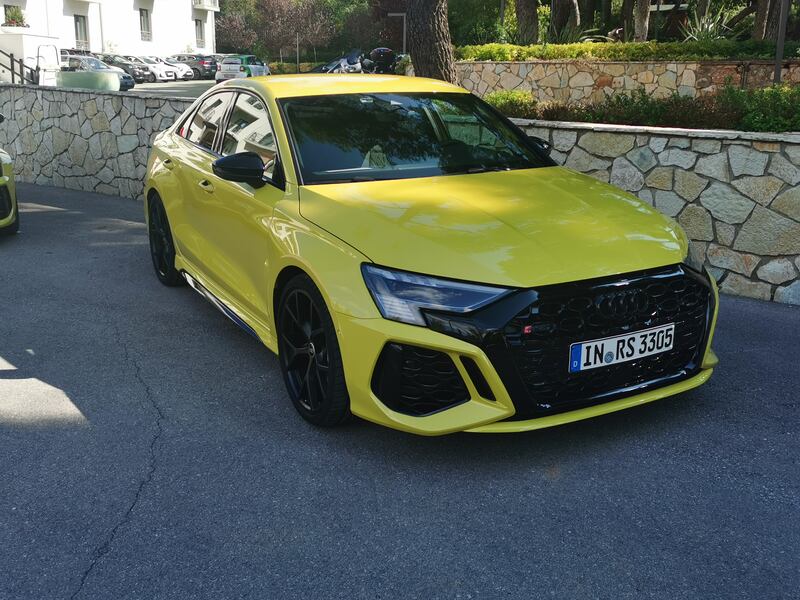The moment I started the new Audi RS3, well before engaging a gear and heading off, I knew this was going to be a good day.
With a distinctive bark from under the hood from that luscious five-cylinder turbo engine, which evokes memories of a bygone era of rallying, the RS3 hits the emotive touchpoints its German competitors miss.
European noise and emission regulations are curtailing the emotional input into cars such as these and for that, the new RS3 has lost the exhaust crackle and pops, but unlike other German brands that have waved the white flag for driver engagement, Audi has traded the raucous exhaust for more under-hood induction. It’ll take in-the-know petrolheads back to the late 1980s when Audi dominated world rallying with an engine not too dissimilar to the beast under the hood of the RS3.

The National is the only Middle East media organisation at the global reveal of the third generation of the pocket rocket in Greece, and while we’re still waiting on confirmation to see if it will be coming to our region, there was another reason to jump on a plane and chase it down ourselves.
This is one of the last European performance cars that delivers its performance without electrification add-ons. At 1,570 kilograms, it’s more than 100kgs lighter than the BMW M4, which equals fuel efficiency and reduced emissions.
While both reach 100 kilometres per hour in the same 3.8 seconds, the Audi does it with 73 fewer horses under the hood, yet still tops out at 290kph in RS Dynamic mode from its 2.5-litre, TFSI five-cylinder engine.
Being an all-wheel drive, the RS3, along with most Audis, have suffered from understeer that has dampened the enjoyment on windy roads. However, that has been eliminated with a clever new rear diff, which alters the torque to each rear wheel via an electronically controlled clutch on either side. This transfers weight on turn in, to the point where the RS3 offers a Drift Mode for the first time for track-day giggles.
The RS Torque Splitter rear diff is different from other torque vectoring units, which use the ABS to brake an inside wheel on tight corners. The Audi system goes the opposite way by sending more torque to the outer wheel, so turn left and it sends torque to the right rear, which in Drift Mode is up to 100 per cent, handling up to 1,750Nm per wheel if needed.
All up, there are eight drive modes ranging from Efficiency, which introduces coasting at idle, through to Comfort, Auto, Dynamic, RS Individual, two modes of RS Performance and RS Torque Rear for drifting. RS Performance can be set for either smooth circuits or bumpy tracks such as the Nordschleife.

Former DTM driver Frank Stippler used this setting to full advantage to set a Nurburgring class record five seconds under the previous time with 7:40.748. It wore semi-slick, Pirelli P Zero Trofeo R tyres, but that’s considered showroom spec as Audi now offers these as an option for track days. Our test car wore the more modest 265/30 (front) and 245/35 (rear) Bridgestone S001 Potenzas.
The reality, when kept in Dynamic mode for quick country road driving, is a car that feeds information back to the driver through the wheel and feels like it pivots on its sump plug with laser accuracy – unlike any Audi in recent memory.

On winding roads, it lets you aim squarely at an apex, feel its nose tuck in tight, then even with a slight lift of the throttle, induce a touch of oversteer. If anything, it feels more mid-engined or rear-wheel driven, but thankfully has lost the traditional, all-wheel drive front-end washout.
The RS3 is accentuated by fully variable exhaust flaps that highlight the music from a motor that gives an extra 20Nm of torque, offering 500Nm from 1,800rpm through a seven-speed S-tronic dual-clutch transmission with shorter shifting times, delivering the same 400hp as the previous model, but arriving earlier at 5,600rpm.
Behind the 19-inch rims is a set of six-piston, 375mm x 36mm steel discs or optional 380mm x 38mm carbon-fibre units that save 10kg of unsprung weight. The front wheels sit 33mm further apart and the rear track is 10mm wider.
The interior, save for a few colour-coded dash highlights, carbon-fibre accents and hugging seats, is regular A3. It incorporates a 10.1-inch touchscreen in the centre that can be controlled via the steering wheel buttons or voice commands, and a 12.3-inch TFT display main dash, while it supports Apple CarPlay and Android Auto with wireless charging.
Outside, it’s instantly identifiable by its wider front bumper that houses air inlets for the brakes and intercooler as well as its huge gloss-black honeycomb grille.
As with the current RS3, Audi is offering both sedan and five-door hatch options, though which ones we’ll see in this region has yet to be determined if it gets signed off for the Middle East at all, but we remain confident.
As for pricing, globally, it hasn’t been locked in for most markets yet, but the trend from each is that it will be a premium over the current Dh247,000 when deliveries begin in the second quarter of next year.






